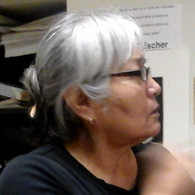McHorse, Christine

“The ribbons and things are just bonuses. What I like is the opportunity to work without restraint.”
Christine Nofchissey was born in December, 1948, and grew up mostly in the Clifton-Morenci area of Arizona. Her father was a heavy equipment operator in the open pit copper mines there. The family had been removed from the Navajo Nation and placed where they would most likely melt into the local population. However, Mark and Ethel Yazzie Nofchissey were not average Dineh, they simply preferred to take “roads less taken.” While most Native Americans employed at the Phelps Dodge Morenci Copper Mine lived in a large tent city, their family bought a house and lived in nearby Clifton. At home they spoke English and they and their father’s niece’s children were the only Indian children in the Clifton schools. In addition, Mark was fascinated with Zen philosophy and the literature of the Rosicrucians. The children grew up in a home environment of creative ideas backed by creative mentoring. They were encouraged to exercise their minds and to invent without fear. However, because the Clifton-Morenci area was a major copper mining center, it was also a dangerous, ugly, violent and culturally barren place. Alcoholism was endemic.
Proud to be 100% Dineh, she spent most of her early summers herding sheep with her grandmother near Ganado on the Navajo Nation. When she was fourteen, her older sisters convinced her parents to send her to attend the Institute for American Indian Arts in Santa Fe. The Institute was still young then and many tribes wondered if it might not weaken their people’s connection with their heritage but the opposite proved to be true. Many of the students were hiding out there as an escape from the harsh realities of day-to-day Indian life.
Christine was allowed to attend and graduated in 1966. She started with glassblowing but that was discontinued in her first year there. So then she tried ceramics, jewelry, foundry arts, design and painting. She finished as a jeweler, then she stayed for a couple years of post-graduate study. A year later she married Joel McHorse, a silversmith and general contractor from Taos Pueblo (Joel’s father, Mace McHorse, was an Irish-Texan cowboy, hence the name).
Christine told us she learned most of her pottery making techniques from Joel’s grandmother, Lena Archuleta. Typical Taos pottery is simple and elegant with few decorative elements beyond the surface of micaceous clay. The tiny flecks of mica infuse the clay and act as temper when the clay is fired. When Christine did add a design element, her designs were drawn from the rich pantheon of Dineh tradition.
Christine grew up Dineh (off-reservation), then married a man from Taos Pueblo and lived most of her life among Anglos in Santa Fe. She felt that none of the three cultures had much influence over how she worked: she created whatever she felt the clay suggested that she create. The freedom of expression that came with that extended even to the process whereby she fired her pots.
Some pots she fired the Navajo way, in a pit outdoors, then she coated them in pinon pitch. Others she fired indoors in a kiln. Still others she fired in a kiln, then refired outdoors to produce the interaction between fire and pinon pitch that she felt the fire clouds on a particular piece demanded. Always, she approached her art with the depth of Dineh spirituality and Earth-connection infused in her during those long summers spent on the Navajo Reservation with her grandmother.
Christine’s resume lists pages of honors and awards she earned and exhibitions she participated in over the years, beginning with her first submission to the Santa Fe Indian Market in 1984. She earned at least one blue ribbon almost every year she went to the Santa Fe Market. In 1992 she went to Santa Fe with only 2 pots, entered them in 2 different categories, earned 2 blue ribbons, returned to her booth and a waiting line of would-be buyers. She was headed back home by mid-morning of the first day, sold out.
Christine didn’t participate in Indian Market any more after that. She’d graduated to the world stage and her work was being shown in exhibitions and galleries from Santa Fe to New York to Canada and Germany.
While Christine may not have participated in Santa Fe’s Indian Market in her later years, she did participate for several years in the Best of the Best Show at Andrea Fisher Fine Pottery. The Best of the Best Show opened for several years just before Indian Market officially began.
Sadly, Christine passed away February 17, 2021.
Some Exhibits that featured works by Christine
- Catch 22: Paradox on Paper. Ralph T. Coe Foundation for the Arts. Santa Fe, New Mexico. August 12, 2017 – March 31, 2018. Note: group show curated by Nina Sanders and based on the Edward J. Guarino Collection
- Christine Nofchissey McHorse: Ceramics, Bronzes, Steel, and Drawings. Peters Project. Santa Fe, New Mexico. August 12, 2016 – November 5, 2016. Note: exhibit title also appears as “The Micaceous Ceramics of Christine Nofchissey McHorse”
- Home: Native Peoples in the Southwest. Heard Museum. Phoenix, Arizona. Opened May 22, 2005
- Anii Ánáádaalyaa̕ ígíí (Recent Ones That Are Made): Continuity & Innovation in Recent Navajo Art. Wheelwright Museum of the American Indian. Santa Fe, New Mexico. July 10, 1988 – October 30, 1988. Note: curators: Bruce D. Bernstein and Susan Brown McGreevy